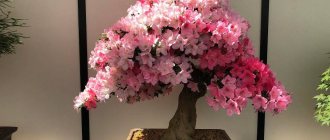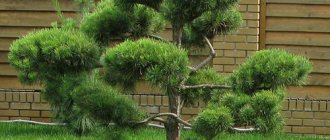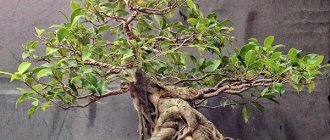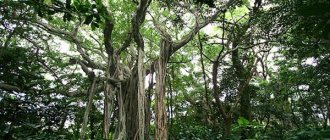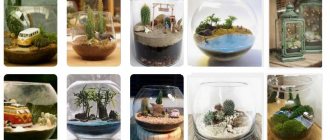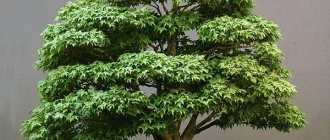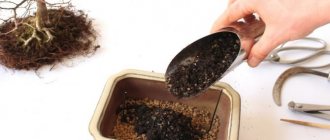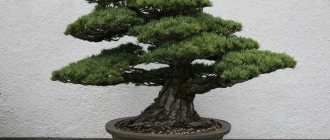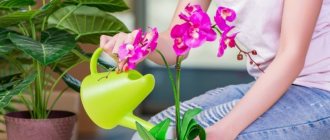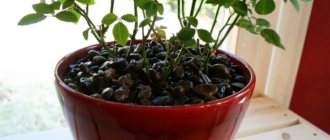Bonsai is the whole art of growing small trees with a graceful silhouette, which has relatively recently entered our lives. The homeland of bonsai is Japan. Literally, bonsai means “plant on a tray.” This miniature tree, grown at home, will add coziness and will serve as a wonderful decoration for the interior of every home. For growing bonsai in Russia, at home, the most popular plants are ficus benjamina, myrtle, and azalea.
Growing this type of plant at home is not so easy, and only diligent, careful and patient people can do it. You should not think that once you create the shape of a tree, it will remain forever. Bonsai, like all living things, is characterized by constant growth, positive or negative changes, and development. In general terms, caring for this plant includes regular pruning, watering and timely replanting.
What is bonsai
Pun sai or bonsai is a tree with a thickened trunk, a properly formed crown, and a height of 20 cm to 2 m. Growth is hampered by a lack of minerals, regular pruning of branches, young shoots, and roots.
Bonsai sizes may vary:
- large – 60-120 cm;
- average – 30-60 cm;
- small – 15-30 cm;
- miniature, “nail size” or “baby” – 5-15 cm.
Indoor bonsai
Reproduction of tea sageretia
This plant is considered one of the easiest bonsai species to propagate. Cuttings are cut from young branches and must be treated with growth accelerators. In a loose and light substrate, provided that stable soil and air humidity are maintained and bottom heating is provided, the cuttings take root easily. Rapid growth allows you to form a plant in a relatively short period. The basic shape and style are set for the cuttings immediately, starting pruning on the plants a few weeks after transplanting.
Sageretia seeds are very rare on sale; they are almost impossible to order. But if by some miracle they ended up in your collection, then sowing is carried out with a light cover of light soil. Containers with sageretia crops are placed in hot temperatures with bottom heating and in bright light, covering them with film or glass on top. Seedlings dive after releasing the second leaf. The formation of sagerecia begins with the beginning of its growth.
Bonsai styles
Before you start creating, study the common types of bonsai:
- Tekkan or Chokkan is a symmetrical tree with a straight, powerful trunk. The center is decorated with three main branches, there are none below, large roots peek out from the ground. The style is applicable to any trees.
- Syakan, Mayogi - a slightly tilted tree.
- Kengai, Fukinagashi - a tree strongly inclined to the side. It grows in a deeper pot, the branches are located in one part of the trunk, directed in one direction.
- Khan-kengai - at first the trunk grows straight, then it bends to the side, the branches can bend over the edge of the pot.
- Ishizuki - translated as growing on a rock. The pot is filled with large stones, which subsequently entwine the roots.
- Kabudati is a forked trunk. The two main branches differ in thickness.
- Yose-ue, Hokidachi - several plants can be used, many trunks, the shape resembles a fan.
- Sokan - two identical trunks grow from one root.
- Sankan - three trunks from one root.
- Yose-Yu is a mini-forest. Several different trees are used.
- Ikadabuki – translated as “raft” or “multiple-trunked tree”. The trunk can be knocked down to the ground, the branches pointing upward.
- Sharimiki - there is dead bark. When growing on the trunk, certain areas are cut off and bleached.
- Bankan is a twisted trunk.
- Neagari - roots protrude from the ground. The best products come from tropical plants with aerial roots.
Bonsai in a pot
Remember that the selection of container depends on the style of bonsai. Cascading and sloping trees require heavy, stable pots to support the weight of the sloping crown. If you are just starting to practice the art, choose the Tekkan or Chokkan style.
Watering and air humidity
The vast majority of trees used to produce bonsai are sensitive to air humidity. It will be very difficult to maintain the attractiveness of the shapes and greenery of these plants without measures to increase air humidity. Installing special humidifiers is an ideal option, but you can increase air humidity by placing bowls with water and spraying (tolerance to the latter should be checked for each type of plant separately).
Watering for bonsai requires much more effort than for ordinary plants. The flat shape of the containers determines the schedule of more frequent procedures. There are no general requirements for watering and their frequency for bonsai plants, but it is important to never forget one rule: bonsai roots should never be allowed to dry out. Drought is detrimental to these valuable plants. But acidification of the soil is also unacceptable. Consistent light to medium humidity is the environment in which most bonsai will thrive. During the cold season, watering is reduced (for deciduous bonsai it is minimal, and for evergreen bonsai the humidity of the substrate is halved), still preventing the substrate from completely drying out.
Bonsai is most often watered using the classic “top” method. But there is one “but”: such plants prefer watering with a sprinkler attachment. It is necessary to resort to water dispersion so that the water is distributed more evenly over a wide container. An alternative method of watering is to immerse the container in a larger container of water to saturate the substrate, followed by complete drainage of the “free” water.
Watering bonsai
What plants are suitable for growing bonsai?
Choose trees and shrubs that eventually develop a lignified trunk and powerful branches. Give preference to crops that suit your climatic conditions. Avoid choosing plants with large flowers, large fruits and leaves. Suitable options for indoor bonsai:
- dwarf bamboo – originally from China, heat-loving;
- cypress - a subtropical species, it is possible to grow bonsai on a balcony or terrace;
- rosemary - unpretentious;
- olive – can bear fruit;
- Buckthorn is a poisonous berry, so it is not advisable to plant it if you have pets or small children;
- boxwood - unpretentious;
- Chinese elm is resilient and does not require complex care;
- common ficus – ideal for home and office, unpretentious;
- myrtle is evergreen, has a pleasant smell, blooms, and releases bactericidal essential oils.
Olive bonsai
At home, grow non-deciduous crops that can grow year-round. It is better for beginners to practice on ficus benjamina, portulacaria africanica. More options for creating compositions:
| Conifers | Deciduous | Blooming |
|
|
|
Caring for tea sageretia at home
Tea sageretia still requires attention and care no less than any other bonsai. Sageretia loves fresh air, high humidity, and is sensitive to mistakes in watering. But thanks to its ability to adapt to warm wintering, it can be considered a species that is perfect for beginners in the art of bonsai. Sageretia is especially suitable for those who want to try their hand at shaping and pruning, because most often the plants are sold unformed.
The most difficult thing about growing a plant is purchasing. Sageretia most often gets sick and dies due to inattentive inspection and selection of plants that are already infected or have suffered from improper maintenance. Any traces of deformation, drying out, withering, or accumulation of dust indicate problems that will be difficult to overcome later without sufficient experience.
Bonsai Sageretia thea
How to grow bonsai yourself
Decide in advance on the method of growing indoor bonsai - from seeds or cuttings. Seeds can be purchased or taken after they are fully ripe from a suitable plant in a park, forest or garden. Planting takes place from spring to early autumn:
- In the fall, sow hard-shelled seeds in a flat container with damp sand and place the container outside throughout the winter. The top layer of seeds will crack due to frost, and shoots will appear in the spring. When sprouts appear, water them. Sow soft-shelled seeds in a box and keep them at a temperature of about 0 degrees.
- In June, cut branches 5-7 cm long, place them in a substrate, water them, cover the pot with a glass jar or film, and place them in a warm place with diffused light. When young shoots appear, remove the jar or film. Please note that coniferous cuttings develop roots within a few months or a year.
Bonsai care
Create an indoor bonsai using:
- concave cutters - for cutting wire, branches for the trunk;
- convex pliers - they safely cut convex elements on the trunk, branches, roots;
- special nippers or scissors for removing roots - they have a curved head;
- tweezers with a curved tip - for removing buds, foliage, pine needles.
Choosing a pot
Root the plant in a large, deep pot. This way the trunk will actively develop. Form the bonsai tree for about 2 years, then move it to a permanent container. The container should be of a simple, laconic shape, harmoniously combined with the composition. Buy a container for the seedling based on the chosen style of your indoor bonsai:
- inclined trees - heavy, stable pots made of clay, ceramics;
- dense, branched crown, several trunks - wide, shallow containers;
- open horses - tall, narrow containers;
- cascade style - narrow shallow pots.
How to choose a bonsai pot size
Basic rules for choosing a pot:
- The height of the walls should not be less than the diameter of the trunk.
- The width is equal to 2/3 of the length of the indoor plant.
- There must be drainage holes.
Soil preparation
Choose ready-made mixtures very carefully. Do not buy peat compounds with garden fertilizers. It is better to purchase a minimally nutritious, permeable substrate processed by California worms. Use scanty soil that prevents the active growth of indoor bonsai:
- For coniferous trees, take 6 parts clay and 4 parts sand.
- For deciduous soil, a mixture of 7 parts clay soil and 3 parts sand soil is suitable.
- For flowering plants - 6 parts clay soil, 1 part leaf humus.
Preparing the soil for growing bonsai
Prepare the soil in April, after the ground has thawed. Universal mixture: 1/3 part clay, ½ part peat or rotted leaves, ¼ part sand and vermiculite, small stones. Before use, rinse the sand thoroughly, calcine the soil for about an hour in the oven at a temperature of 100-120 degrees or boil for half an hour in a sieve and water.
First transplant
Rooting is carried out in a shaded place:
- Trim vertically growing roots. With this formation, the growth of the tree slows down.
- Plant the bonsai in the substrate, compact it, water it.
- Arrange a quarantine for the plant: choose a slightly shaded place for the pot, isolated from other plants.
Bonsai transplant
Prevention and control of common diseases and pests
Withered bonsai
Black Pine Dead Branch Disease
When black pine suffers from dead limb disease, it can cause the plant's leaves to turn yellow and even directly wilt and die. Once the disease is detected, the affected branches and leaves should be removed in time, and then sprayed with methylthiomycin solution for prevention and control.
Pine aphid
Once a black pine tree is infested with a large pine aphid, it will suck the sap from the tender parts of the plant and overall growth will become poor. After detecting a pest, manual destruction should be carried out in a timely manner, but, as a rule, this is more of a palliative than a cure, so for prevention and control it is necessary to spray with Bordeaux mixture
Conclusion: After reading the above, I believe that everyone should know how to care for a black pine bonsai. Remember to trim it at the usual time. Only judicious pruning can make black pine grow and look better.
How to care for an adult plant
Each plant variety has individual preferences for climate, lighting, temperature, air humidity, and watering. Before you acquire a particular crop, read the recommendations for keeping it at home.
Climatic conditions
Basic rules for growing indoor bonsai:
- Lighting. There should be no direct sunlight. It is desirable that the light be diffused in summer and bright in winter. During the day, from 11:00 to 16:00, periodically turn the plant with different sides to the sun. This will help form a beautiful crown.
- Ventilation. Accustom your bonsai to the open air gradually. Every day in the summer, take him outside for 5-10 minutes, subsequently increasing the “walk” time.
- Temperature conditions. Indoor bonsai develop well at temperatures of +10-25 degrees. The minimum indicators for coniferous species are 10 degrees, for deciduous, flowering species - 12-14 degrees.
Watering and air humidity
Watering bonsai
To water indoor bonsai, warm, soft, filtered, rain or melt water is used. The procedure is carried out early in the morning or in the evening. If the sun is shining brightly, the liquid should not get on the foliage. Basic rules for watering indoor bonsai:
- To moisten a clod of earth in a small container, use the water immersion method. To do this, dip the bonsai pot in a bowl of liquid for several hours. Water from above until water flows out of the drainage holes. Half an hour after watering, drain the excess liquid.
- Moisten the soil, taking into account the individual characteristics of the plant. Some tolerate drought well, others suffer and immediately drop leaves, flowers, and fruits.
- In summer, watering should be frequent, sometimes daily, in winter – sparing, about once a week.
- The top layer of soil should dry out between waterings.
- In summer, spray tropical plants daily early in the morning. Use a humidifier. In addition, a water bath is useful: expanded clay, sand, moss, stones (elements that absorb and release moisture) are placed in a deep bowl, everything is filled with water, and a bonsai pot is placed on top. This procedure can be combined with spraying.
Bonsai watering mode
Fertilizer application
Use special fertilizers for bonsai or indoor plants:
- To stop growth, reduce the dosage indicated on the label by 2-3 times.
- Do not feed a diseased, recently pruned or transplanted plant.
- Apply compounds after watering.
- The feeding regime depends on the type of crop. A common scheme is once every 1-2 weeks. Take breaks in the summer to stop shoot growth and improve lignification. Feed evergreen indoor bonsai every 3-6 weeks during the winter.
- Feed coniferous trees 2 times less than other species.
Plant pruning
Use pre-disinfected scissors. Pruning of slow-growing indoor bonsai is carried out annually, in the spring, after the first buds appear. Branches that thicken the crown too much are removed. Young shoots leave 1-2 pairs of leaves.
Bonsai pruning
Fast-growing trees require regular pruning throughout the year. The more often the procedure is performed, the smaller and denser the crown will be. Trim off unnecessary and overly long branches. Treat the cut areas with crushed coal.
Procedure for pruning indoor bonsai:
- Find and shorten the apical, strongest shoot. There should be 3-5 leaves or buds left.
- Shape the crown so that it resembles an irregular truncated cone. Trim the side branches to the desired length. The first leaves on the shoots should point down. This way the branches will grow horizontally.
- Cut vertically growing side shoots to 1-3 leaves. These branches will properly thicken the crown.
- If 2 strong branches interfere with each other's growth, remove one of them so that it does not harm the overall silhouette of the indoor bonsai.
Creating a wireframe
Wire frame
Create a style immediately after planting your indoor bonsai in the first pot:
- Use aluminum or copper wire, the thickness of which corresponds to the branches, the length is 1.5 times the area to be wrapped.
- Bury one end of the wire and secure it in the ground, then wrap the trunk and branches, giving them the desired direction.
- Press the wire firmly against the trunk without damaging the bark.
- Remove the frame from the branches after 6-8 months, from the trunk - after 1.5-2 years.
- Repot your indoor bonsai into a permanent pot.
Transfer
Indoor bonsai does not require frequent replanting. The procedure is carried out every 3-5 years, in early spring. Transplantation is necessary for two-year-old indoor plants when the first buds appear. It is better not to touch flowering crops and postpone the procedure until autumn.
Step by step replanting bonsai
To stop the upward development of bonsai, trim the vertical roots. The taproot and thick roots are removed if the lateral roots are well developed. If all the roots are weak, leave them and change the direction with a wire. Leave thicker, stronger roots above the ground. Cover the top of the soil with moss.
Top dressing
The feeding mode for bonsai starts once and for all. When purchasing a finished copy, this point should definitely be clarified. The classic fertilizer scheme looks like this: starting in April, they are applied 2-3 times a month or weekly. Then, in the middle of summer, a break of up to a month is taken so that the shoots stop growing a little and become lignified better. In autumn, the frequency of applications can be halved. It is not worth stopping feeding evergreen specimens in winter, but the dosage, compared to summer, is halved, and the frequency is reduced to 1 time in 1.5 months.
What fertilizers should I use? It is advisable to use only special ones, which are sold by companies specializing in their cultivation. You can also select ready-made formulations from universal manufacturers who have a wide range of offers.
